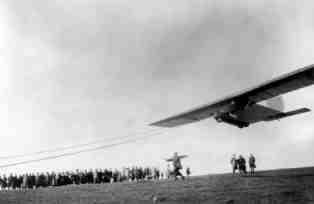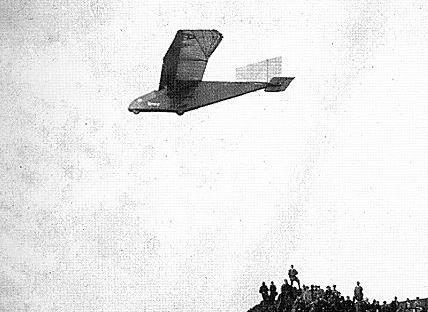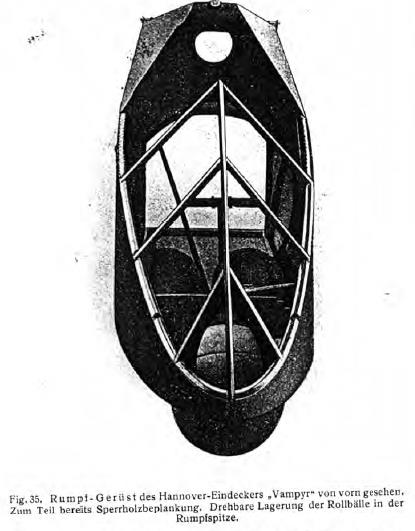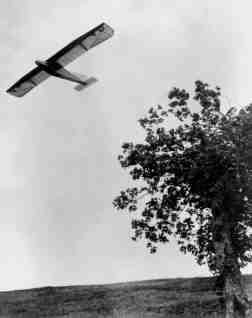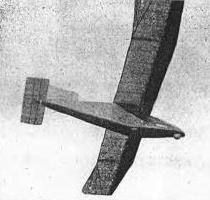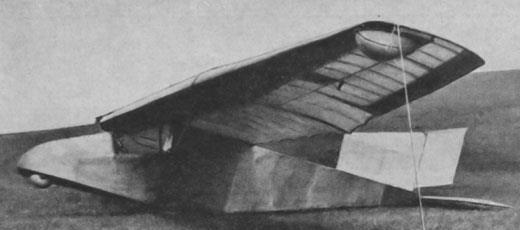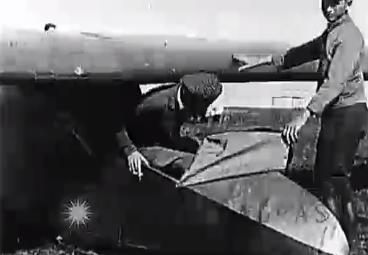| Type | 1921 | 1922 | ||
| Dimensions | Length 4,92 m, height 1,4 m, span 12,6 m, wing area 16,1 m2 | |||
| Weights | Empty 120 kg, max. flying weight 195 kg, wing load 12,2 kg/m2 | |||
| Performance | Min. speed 39 km/h, glide ratio 16, min. sink 0,8 m/sec. | |||
| Type | Werk.Nr | Registration | History | |
| Wing profile Gö 441/482. Took part in the Rhön 1921. Rebuilt during the winter, The Vampyr refined with greater wing area and wing warping in lieu of ailerons. Flown with success at the 1922 Rhön competition | ||||
Weltrekordflug des Vampyrs in der Rhön 1921
Am 30. 08. 1921 machte Klemperer (Aachen) seinen in der Öffentlichkeit bekannt gewordenen ersten großen Überlandflug nach Hersfeld, Dauer 13 Minuten, Entfernung in Luftlinie gemessen 5 km. Er hatte auf diesem Flug einen Wind von 10-12 m/s, d.h. auf deutsch "Sturm". Leider war an diesem Tag unsere Maschine nicht startbereit, so daß wir uns auf einen anderen Tag vertrösten mußten.
Vampyr in aktion Dieser Tag kam am 5.September. Es wehte ein Wind von etwa 4-8 m/s aus Richtung NNW.
Gegen 1/2 2 Uhr sind wir startbereit mit unserem Segler am ziemlich steilen Nordhange der Wasserkuppe. Der Start geht glatt vonstatten, und ich wende mich zunächst östlich, um zu versuchen, so lange wie irgend möglich, vorm Hange kreuzend, zu segeln. Die erste Schwenkung kommt, und ruhig zieht der Segler seinen Kurs wieder in Richtung Abflugstelle. Aber sehr bald merke ich, daß die Windstärke nicht ausreicht, um ein langes Kreuzen und Kurven vor dem Hang zu ermöglichen. Kurz entschlossen drehe ich nach NO ab mit der Absicht, auf diese Weise möglichst weite Strecke und lange Zeit herauszuholen. Betrachtet man die Karte, so wird das aufmerksam beobachtende Auge sofort erkennen, daß die Flugrichtung wohldurchdacht war, denn sie zieht sich ganz an Hängen lang, so daß fast überall die Hubkraft des sogenannten Hangwindes ausgenutzt werden konnte zur Erhaltung der Höhe.
Von Augenzeugen wurde festgestellt, daß der Segler drei Minuten nach dem Start noch höher war als der Abflugort.
Als ich nach NO abdrehe, sehe ich noch einmal die am Startort stehenden winken, ein frohes "Glück ab" für die Reise. An einer Schnur um den Hals hängt meine Uhr. Viel zu langsam eilen ihre Zeiger.
Ich bemühe mich, jede unnütze Steuerbewegung zu vermeiden, um ja keine Höhe zu verlieren. Links bleibt Reulbach unter mir liegen. Ich sehe wie die Dorfbewohner in den Straßen laufen, sehe wie sie sich gegenseitig den großen Vogel zeigen. Vereinzelte Rufe dringen herauf. - Denn es ist ja totenstill, kein Motorengeräusch, kein Singen von Spanndrähten!!
50 Meter unter mir liegt der "Unkenhof". Ein Knecht spannt gerade seine Pferde an. Es reizt mich, mich mit ihm zu unterhalten. Ich rufe ihn an: "Willst du aufs Feld fahren?" Er sieht sich ratlos um, dann, plötzlich, ein Schatten huschte über den Hof, sieht er den großen, ruhigen Vogel.!!
Geantwortet hat er nicht, er ließ Pferd und Wagen stehen und verschwand im Eilschritt in der Scheune! Sollte er an den Teufel geglaubt haben?
Langsam geht meine Höhe verloren. Nervös sehe ich auf die Uhr, zum zehnten Male vielleicht.
12 Minuten sind herum und vor mir noch über 2 Kilometer Flugweg! Wenn nicht irgendetwas Unvorhergesehenes eintritt, muß ich Klemperers Zeit schaffen, muß sie überbieten! 30 m hoch über einem Kartoffelacker. In langer Reihe hocken emsig arbeitend die Kartoffelleser. Ich bin mitten über ihnen, und keiner hat mich bisher bemerkt!
Vampyr in aktion "Was machen die Kartoffeln?" erschalllt eine Stimme von oben. Ratloses hin und her.
Dann - einer sieht herauf! - einen Augenblick Ruhe.
Dann ein vielstimmiges Rufen.......
Rauchschwaden von schwelenden Kartoffelfeuern zeigen mir die Windrichtung. Der Wind hat nachgelassen. Ich liege im Windschatten des gegen-überliegenden Berges. Ein Blick auf die Uhr!
"Geschafft!"- 13 Minuten sind überschritten! Im Gleitfluge geht es über die Bahn Batten/Wüstensachsen. Links liegt das Dorf! Vor mir ein Kleestück! - Ich bin keine 10 Meter mehr hoch! - Einige Sekunden - und leicht setzt sich der Vogel in den hohen Klee! Leute eilen herbei! - Großes Staunen über den seltsamen Besuch und viele, viele Fragen.- (...)
Tief in der Dunkelheit landeten wir wieder auf der Kuppe und der brave Vogel konnte sein wohlverdientes Nachtlager aufsuchen.
Mit diesem Fluge brachte ich zwei neue Weltrekorde an unsere Maschine, den Zeit- und Streckenrekord für motorlosen Flug.
Dauer: 15 Min. 40 Sek., Entfernung zwischen Start und Landeplatz in Luftlinie gemessen 7500 m.
Im Winter 1921/22 wurde der Flügel überarbeitet und bekam eine Verwindung. Gleichzeitig konstruierte dasselbe Team den "Greif" als Diplomarbeit. Gleichwohl der "Greif" die neuere Konstruktion war, gewann der "Vampyr" die meisten Preise. Nach dem ersten Stundenflug wurde die Flugzeit schnell gesteigert. Der "Greif" entsprach nicht den Erwartungen, wohl, weil der Rumpfausschnitt zuviel Widerstand erzeugte. Der "Vampyr" wurde 1926/27 nach dem Zugspitzflug von der Gruppe in Bayern "gelassen".
Am 30. 08. 1921 machte Klemperer (Aachen) seinen in der Öffentlichkeit bekannt gewordenen ersten großen Überlandflug nach Hersfeld, Dauer 13 Minuten, Entfernung in Luftlinie gemessen 5 km. Er hatte auf diesem Flug einen Wind von 10-12 m/s, d.h. auf deutsch "Sturm". Leider war an diesem Tag unsere Maschine nicht startbereit, so daß wir uns auf einen anderen Tag vertrösten mußten.
Vampyr in aktion Dieser Tag kam am 5.September. Es wehte ein Wind von etwa 4-8 m/s aus Richtung NNW.
Gegen 1/2 2 Uhr sind wir startbereit mit unserem Segler am ziemlich steilen Nordhange der Wasserkuppe. Der Start geht glatt vonstatten, und ich wende mich zunächst östlich, um zu versuchen, so lange wie irgend möglich, vorm Hange kreuzend, zu segeln. Die erste Schwenkung kommt, und ruhig zieht der Segler seinen Kurs wieder in Richtung Abflugstelle. Aber sehr bald merke ich, daß die Windstärke nicht ausreicht, um ein langes Kreuzen und Kurven vor dem Hang zu ermöglichen. Kurz entschlossen drehe ich nach NO ab mit der Absicht, auf diese Weise möglichst weite Strecke und lange Zeit herauszuholen. Betrachtet man die Karte, so wird das aufmerksam beobachtende Auge sofort erkennen, daß die Flugrichtung wohldurchdacht war, denn sie zieht sich ganz an Hängen lang, so daß fast überall die Hubkraft des sogenannten Hangwindes ausgenutzt werden konnte zur Erhaltung der Höhe.
Von Augenzeugen wurde festgestellt, daß der Segler drei Minuten nach dem Start noch höher war als der Abflugort.
Als ich nach NO abdrehe, sehe ich noch einmal die am Startort stehenden winken, ein frohes "Glück ab" für die Reise. An einer Schnur um den Hals hängt meine Uhr. Viel zu langsam eilen ihre Zeiger.
Ich bemühe mich, jede unnütze Steuerbewegung zu vermeiden, um ja keine Höhe zu verlieren. Links bleibt Reulbach unter mir liegen. Ich sehe wie die Dorfbewohner in den Straßen laufen, sehe wie sie sich gegenseitig den großen Vogel zeigen. Vereinzelte Rufe dringen herauf. - Denn es ist ja totenstill, kein Motorengeräusch, kein Singen von Spanndrähten!!
50 Meter unter mir liegt der "Unkenhof". Ein Knecht spannt gerade seine Pferde an. Es reizt mich, mich mit ihm zu unterhalten. Ich rufe ihn an: "Willst du aufs Feld fahren?" Er sieht sich ratlos um, dann, plötzlich, ein Schatten huschte über den Hof, sieht er den großen, ruhigen Vogel.!!
Geantwortet hat er nicht, er ließ Pferd und Wagen stehen und verschwand im Eilschritt in der Scheune! Sollte er an den Teufel geglaubt haben?
Langsam geht meine Höhe verloren. Nervös sehe ich auf die Uhr, zum zehnten Male vielleicht.
12 Minuten sind herum und vor mir noch über 2 Kilometer Flugweg! Wenn nicht irgendetwas Unvorhergesehenes eintritt, muß ich Klemperers Zeit schaffen, muß sie überbieten! 30 m hoch über einem Kartoffelacker. In langer Reihe hocken emsig arbeitend die Kartoffelleser. Ich bin mitten über ihnen, und keiner hat mich bisher bemerkt!
Vampyr in aktion "Was machen die Kartoffeln?" erschalllt eine Stimme von oben. Ratloses hin und her.
Dann - einer sieht herauf! - einen Augenblick Ruhe.
Dann ein vielstimmiges Rufen.......
Rauchschwaden von schwelenden Kartoffelfeuern zeigen mir die Windrichtung. Der Wind hat nachgelassen. Ich liege im Windschatten des gegen-überliegenden Berges. Ein Blick auf die Uhr!
"Geschafft!"- 13 Minuten sind überschritten! Im Gleitfluge geht es über die Bahn Batten/Wüstensachsen. Links liegt das Dorf! Vor mir ein Kleestück! - Ich bin keine 10 Meter mehr hoch! - Einige Sekunden - und leicht setzt sich der Vogel in den hohen Klee! Leute eilen herbei! - Großes Staunen über den seltsamen Besuch und viele, viele Fragen.- (...)
Tief in der Dunkelheit landeten wir wieder auf der Kuppe und der brave Vogel konnte sein wohlverdientes Nachtlager aufsuchen.
Mit diesem Fluge brachte ich zwei neue Weltrekorde an unsere Maschine, den Zeit- und Streckenrekord für motorlosen Flug.
Dauer: 15 Min. 40 Sek., Entfernung zwischen Start und Landeplatz in Luftlinie gemessen 7500 m.
Im Winter 1921/22 wurde der Flügel überarbeitet und bekam eine Verwindung. Gleichzeitig konstruierte dasselbe Team den "Greif" als Diplomarbeit. Gleichwohl der "Greif" die neuere Konstruktion war, gewann der "Vampyr" die meisten Preise. Nach dem ersten Stundenflug wurde die Flugzeit schnell gesteigert. Der "Greif" entsprach nicht den Erwartungen, wohl, weil der Rumpfausschnitt zuviel Widerstand erzeugte. Der "Vampyr" wurde 1926/27 nach dem Zugspitzflug von der Gruppe in Bayern "gelassen".
It is no exaggeration to say that world-wide admiration has been aroused by the splendid flights made in the Rhön mountains during the recent German gliding competition.
First the news came that Herr Martens had remained aloft for one hour on a Hannover glider. The next day it was announced that a college fellow of Martens, Herr Hentzen,had kept in the air for two hours. This performance, excellent as it was, did not long remain a world's record. A few days later Herr Hent2en increased the duration to 3 hours 10"minutes. How long this record will be allowed to stand there is no way of telling. It may be, however, that exceptionally favourable weather conditions helped materially in enabling this performance to be attained, and that it will be some time before the four-hours mark is reached. On the other hand, if a glider will remain aloft for three hours there is apparently no reason why it should not remain up for any length of time, provided the pilot is physically and mentally capable of sustaining the strain which must of necessity accompany the constant alertness required to take advantage of every gust of wind. However that may be, we congratulate Herr Hentzen on his remarkable feat, and trust to have the pleasure of seeing him in this country, either in connection with this year's Daily Mail competition, or at some future date. In the meantime, a few notes dealing with the glider on which the flights were made may not be without interest.
Generally speaking, the machine used by Martens and Hentzen in the Rhön competition this year is similar to last year's model. Certain modifications have been made, such as a reduction of the wing span, which is obviously somewhat large, and certain other minor alterations. The accompanying general arrangement drawings show last year's model, and it should be kept in mind that certain changes have taken place. However, even last year flights of long duration were made ; for instance, one of 15 minutes
40 seconds, during which Herr Martens covered a distance
of 4 miles. It is understood that, in spite of the reduction in wing span, the wing area has been slightly increased. This would mean that the chord has been increased, and the aspect ratio reduced to more normal proportions.
Fundamentally, the Hannover glider consists of a cantilever monoplane wing of thick, high-lift section and large aspect ratio, mounted en parasol above a rectangular section fuselage. The wing is built in three sections, the central one of which measures approximately 22 ft. in span, with two end sections (tapered) attached to it. The wing section employed is one of the G6ttingen sections, and the wing construction is somewhat unusual inasmuch as there is only one main wing spar. This spar is of I-section, with the web built up of a series of lattices in order to save weight. The spar is located approximately one-third of the chord from the leading edge.
As a single spar, although capable of resisting the bending moments, could not be expected to resist torsion, the wing has been built up in the form of a tube of three-ply wood.
This three-ply extends from the top of the spar, around the leading edge, and back over the lower surface as far as the lower edge of the spar. The tube thus formed, although being quite light, is very stiff against torsion, while at the same time having the advantage that it retains the shape of the leading edge of the wing better than could the usual rib construction. The main ribs are spaced about 18 ins. apart, but in the front portion false nose ribs are placed in the intervals between main ribs, thus supporting the three-ply at short intervals. The rear portion of the wing is covered with fabric in the usual way.
The fuselage, which is of rectangular section, has four longerotis, and is a girder of the usual type, with struts and cross-members, and braced with wire. The wing is attached to the fuselage by three bolts, one through the main spar in the centre, which engages with a fitting on the top longerons (which meet at this point), and two through special reinforced ribs over the full-width edge of the body. In order to reduce the bending moments somewhat, single struts slope out some distance and are attached to the single spar.
A notable feature of the Hannover glider, which, by the way, was designed by Dr. Madelung, is the undercarriage, which consists of three footballs, two side by side under the deepest part of the juselagc. and one under the nose. Two- similar, but smaller, air-filled spheres are housed in the wing tips. In practice this undercarriage is stated to have worked very well, and certainly it w^ould be difficult to imagine anything lighter and simpler. The machine was built for some of the members of the flying club of the Hannover Technical High School by the Hannover Coach and Carriage Works.
First the news came that Herr Martens had remained aloft for one hour on a Hannover glider. The next day it was announced that a college fellow of Martens, Herr Hentzen,had kept in the air for two hours. This performance, excellent as it was, did not long remain a world's record. A few days later Herr Hent2en increased the duration to 3 hours 10"minutes. How long this record will be allowed to stand there is no way of telling. It may be, however, that exceptionally favourable weather conditions helped materially in enabling this performance to be attained, and that it will be some time before the four-hours mark is reached. On the other hand, if a glider will remain aloft for three hours there is apparently no reason why it should not remain up for any length of time, provided the pilot is physically and mentally capable of sustaining the strain which must of necessity accompany the constant alertness required to take advantage of every gust of wind. However that may be, we congratulate Herr Hentzen on his remarkable feat, and trust to have the pleasure of seeing him in this country, either in connection with this year's Daily Mail competition, or at some future date. In the meantime, a few notes dealing with the glider on which the flights were made may not be without interest.
Generally speaking, the machine used by Martens and Hentzen in the Rhön competition this year is similar to last year's model. Certain modifications have been made, such as a reduction of the wing span, which is obviously somewhat large, and certain other minor alterations. The accompanying general arrangement drawings show last year's model, and it should be kept in mind that certain changes have taken place. However, even last year flights of long duration were made ; for instance, one of 15 minutes
40 seconds, during which Herr Martens covered a distance
of 4 miles. It is understood that, in spite of the reduction in wing span, the wing area has been slightly increased. This would mean that the chord has been increased, and the aspect ratio reduced to more normal proportions.
Fundamentally, the Hannover glider consists of a cantilever monoplane wing of thick, high-lift section and large aspect ratio, mounted en parasol above a rectangular section fuselage. The wing is built in three sections, the central one of which measures approximately 22 ft. in span, with two end sections (tapered) attached to it. The wing section employed is one of the G6ttingen sections, and the wing construction is somewhat unusual inasmuch as there is only one main wing spar. This spar is of I-section, with the web built up of a series of lattices in order to save weight. The spar is located approximately one-third of the chord from the leading edge.
As a single spar, although capable of resisting the bending moments, could not be expected to resist torsion, the wing has been built up in the form of a tube of three-ply wood.
This three-ply extends from the top of the spar, around the leading edge, and back over the lower surface as far as the lower edge of the spar. The tube thus formed, although being quite light, is very stiff against torsion, while at the same time having the advantage that it retains the shape of the leading edge of the wing better than could the usual rib construction. The main ribs are spaced about 18 ins. apart, but in the front portion false nose ribs are placed in the intervals between main ribs, thus supporting the three-ply at short intervals. The rear portion of the wing is covered with fabric in the usual way.
The fuselage, which is of rectangular section, has four longerotis, and is a girder of the usual type, with struts and cross-members, and braced with wire. The wing is attached to the fuselage by three bolts, one through the main spar in the centre, which engages with a fitting on the top longerons (which meet at this point), and two through special reinforced ribs over the full-width edge of the body. In order to reduce the bending moments somewhat, single struts slope out some distance and are attached to the single spar.
A notable feature of the Hannover glider, which, by the way, was designed by Dr. Madelung, is the undercarriage, which consists of three footballs, two side by side under the deepest part of the juselagc. and one under the nose. Two- similar, but smaller, air-filled spheres are housed in the wing tips. In practice this undercarriage is stated to have worked very well, and certainly it w^ould be difficult to imagine anything lighter and simpler. The machine was built for some of the members of the flying club of the Hannover Technical High School by the Hannover Coach and Carriage Works.
The Vampyr was designed by George Madelung, with students at the Leibniz Universität Hannover - Hannover Technical University,working under the supervvision of Professor Arthur Proell. The aircraft, built at the Hannoverische Waggonfabrik (HaWa) workshops using wood as the primary material, was simple in appearance, but the Vampyr heralded the structural techniques that were to become commonplace as the sport of gliding progressed:Box framed fuselage covered with plywood as a stressed skin, three piece wings with detachable outer panels, a torsion box leading edge, and an enclosed cockpit (only the pilots head was exposed).
The wings and tail surfaces were covered with fabric, but the leading edges of the wing formed a stressed skin torsion box structural member. Some support for the fuselage was provided by short bracing struts either side, which also served to relieve high bending moments at the centre-line. The use of stressed skin also allowed the wings to be built lightly and with increased span and aspect ratio, with consequent increases in performance.
Flying controls were essentially conventional with fin, rudder, all-flying tailplane, and ailerons on the outer panels on the 1921 version. For the 1922 competition outer panels of increased area and wing-warping control were introduced.
The Vampyr was built specifically to compete in the 1921 Rhön Gliding competition at the Wasserkuppe. Arriving late with only three flying days remaining the Vampyr, given the entry number of 45and flying marking I, flown by Arthur Martens soon demonstrated superior performance over the competition. Several long glides were carried out, unfortunately some long duration flights, which could have taken the first prize, were shortened due to Martens circling. No soaring was witnessed on competition flights, with the exception of the short tragic flight of Leusch in the Weltensegler.
Unfortunately the Vampyr suffered a launch accident on its last launch in the competition, which resulted in other gliders overtaking it on the leader board. Despite the set-back the Vampyr still managed to earn some plaudits:
3rd prize, of 2000 Marks, for lowest mean sinking speed.[2]
2nd prize, of 3,000 Marks, for the longest distance covered.[2]
The Kyffhauser-Flugspende, Frankenhausen Wing prize of 1,000 Marks.[2]
Highest co-efficient of glide (sic) prize of 15,000 Marks[2]
After the competition ended, several gliders stayed behind to hone their skills including the Vampyr, which was swiftly repaired after its launching accident. In early September the Vampyr made a 7.5 kilometre flight but still without soaring.
The Vampyr continued flying after the 1921 competition and appeared at the 1922 Rhön competition with redesigned outer wing panels of greater area featuring wing warping instead of ailerons for roll control.[1] At the 1922 competition steadily improving flights resulted in a flight time of 3hrs 10 min was recorded at an altitude of 350m o 19 August 1922, flown by Frederick Hentzen.
The wings and tail surfaces were covered with fabric, but the leading edges of the wing formed a stressed skin torsion box structural member. Some support for the fuselage was provided by short bracing struts either side, which also served to relieve high bending moments at the centre-line. The use of stressed skin also allowed the wings to be built lightly and with increased span and aspect ratio, with consequent increases in performance.
Flying controls were essentially conventional with fin, rudder, all-flying tailplane, and ailerons on the outer panels on the 1921 version. For the 1922 competition outer panels of increased area and wing-warping control were introduced.
The Vampyr was built specifically to compete in the 1921 Rhön Gliding competition at the Wasserkuppe. Arriving late with only three flying days remaining the Vampyr, given the entry number of 45and flying marking I, flown by Arthur Martens soon demonstrated superior performance over the competition. Several long glides were carried out, unfortunately some long duration flights, which could have taken the first prize, were shortened due to Martens circling. No soaring was witnessed on competition flights, with the exception of the short tragic flight of Leusch in the Weltensegler.
Unfortunately the Vampyr suffered a launch accident on its last launch in the competition, which resulted in other gliders overtaking it on the leader board. Despite the set-back the Vampyr still managed to earn some plaudits:
3rd prize, of 2000 Marks, for lowest mean sinking speed.[2]
2nd prize, of 3,000 Marks, for the longest distance covered.[2]
The Kyffhauser-Flugspende, Frankenhausen Wing prize of 1,000 Marks.[2]
Highest co-efficient of glide (sic) prize of 15,000 Marks[2]
After the competition ended, several gliders stayed behind to hone their skills including the Vampyr, which was swiftly repaired after its launching accident. In early September the Vampyr made a 7.5 kilometre flight but still without soaring.
The Vampyr continued flying after the 1921 competition and appeared at the 1922 Rhön competition with redesigned outer wing panels of greater area featuring wing warping instead of ailerons for roll control.[1] At the 1922 competition steadily improving flights resulted in a flight time of 3hrs 10 min was recorded at an altitude of 350m o 19 August 1922, flown by Frederick Hentzen.

